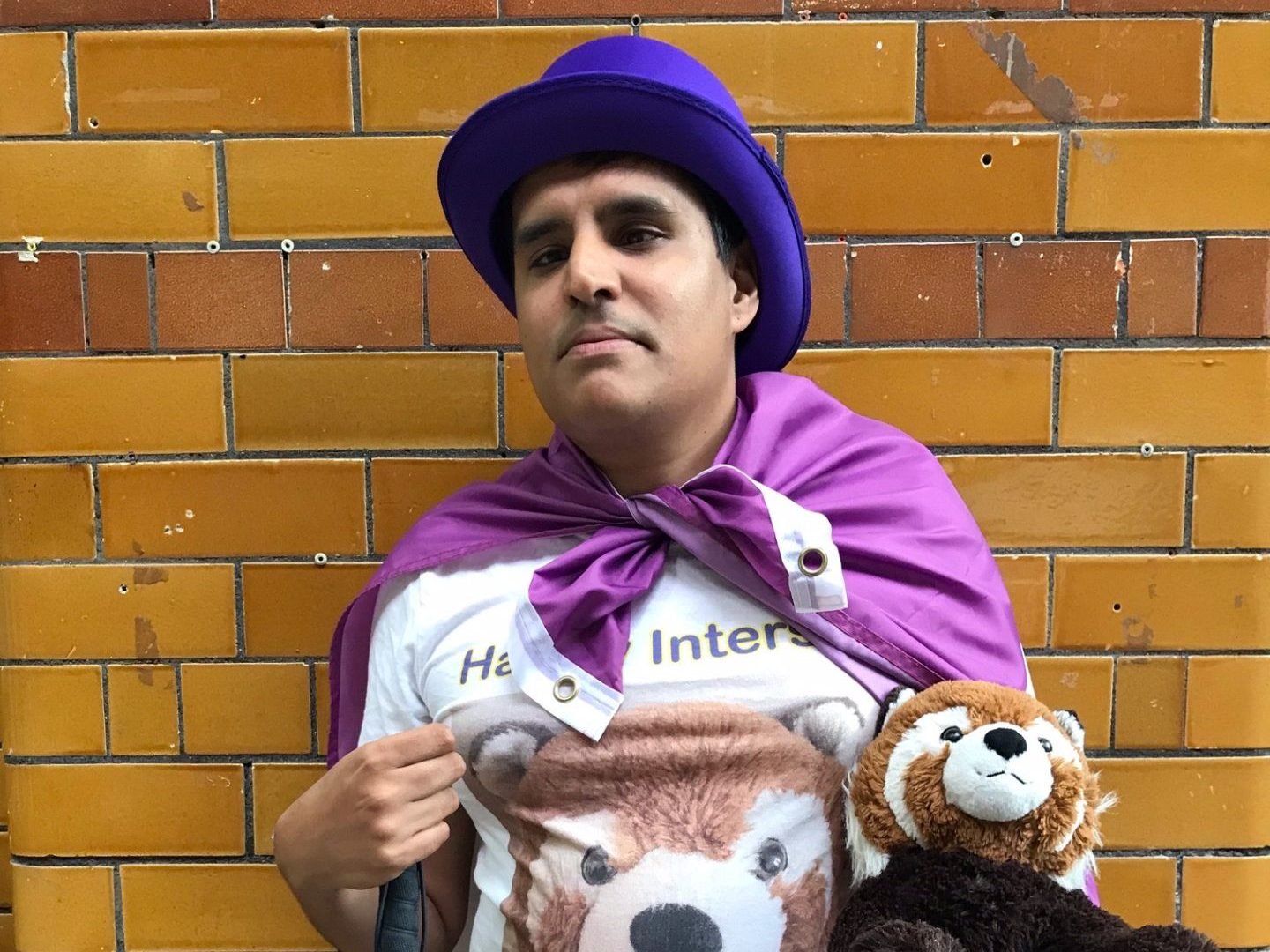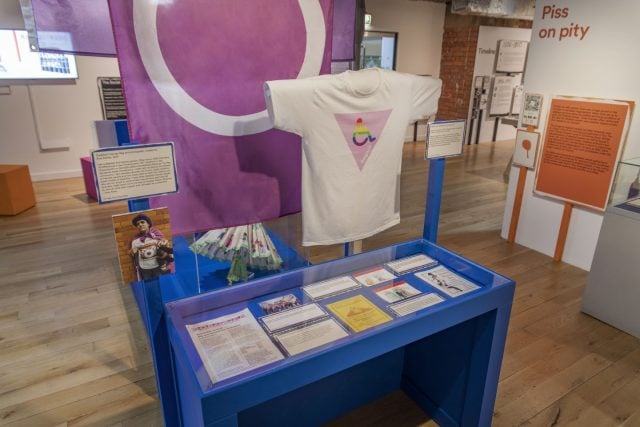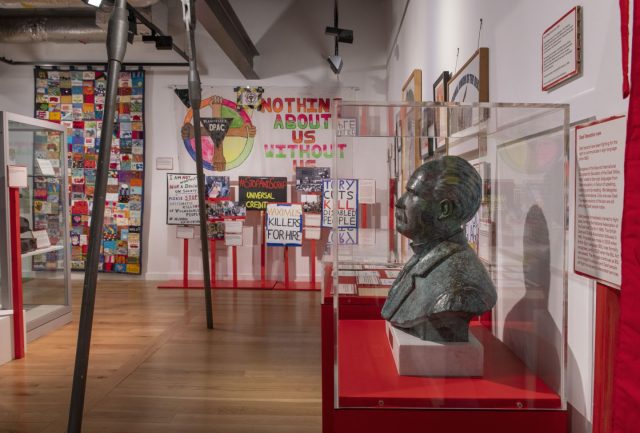
‘Nothing About Us Without Us’: Community curator Anis Aktar on intersectionality within UK’s Disability Rights Movement History
Anis Aktar is a community curator for the landmark exhibition ‘Nothing About Us Without Us’ at the People’s History Museum in Manchester. The exhibition officially launched on 16 November 2022 to mark the first day of UK Disability History Month. MRG’s Lauren Avery interviewed Anis about their experience working on the exhibition and the intersectionality in the UK’s disability rights movement history.
Trigger warning: this interview contains content on honour-based killing.
Thank you for joining us, Anis. Can you briefly introduce yourself?
My name is Anis. My pronouns are they, but I’m happy with any pronouns. I do a lot of activism in Bradford, Leeds and Manchester around people of colour, disabled people and LGBTIQAP+ people. And I’m a Survivor/Ambassador for Karma Nirvana, which is a charity that looks at the honour-based violence system. So everything I do is very much focused on intersectionality and how different social justice movements, equality, diversity and inclusion intersect with each other.
I’ve been visually impaired from birth and attended both a special and mainstream school. I’m very passionate about being a disabled person because ultimately being prescribed to a special school meant that I wasn’t flown to Pakistan and got rid of, like other members of my family because I’m also an intersex person and identify as nonbinary. My family members also have various other impairments and conditions, I have to educate myself on those and attend family conferences around them. So, intersectionality is a huge part of not only myself but also my family; sometimes it’s a lot to shoulder on my own.
I moved to the northwest of England in 2017 to study and live in Liverpool. I learned very quickly that there didn’t seem to be any disabled people’s organization that was looking at pan impairment. There were lots of charities that were impairment specific. I remember when I first moved to Liverpool, one of the first things I did was google mental health, visual impairment, and learning disabilities. And so, I tried to piece together what was going on in the city but I didn’t find much. I’ve always mentioned how if you’re a disabled person and an LGBTIQAP+ person, you may face disablism from the LGBTIQAP+ community and equally you may face LGBTIQAP+ phobia from your disabled peers. So, you end up having to create your own group because you’re facing multiple discrimination.
What has your role been as community curator of the exhibition?
I came on board with this exhibition because I wanted to ensure that the history of the disabled people’s movement did include people of colour and LGBTIQAP+ people and also other sorts of intersectional and marginalized groups. Nothing About Us Without Us has the tagline of ‘disabled people’s activism past, present and future’; we used that so that we could compare and contrast what’s happened in the past, what’s happening now and what’s happening in the future. So, in the exhibition, we have a little room which is the ‘Future’ section. We have things from the young creatives here in Manchester whose identities are quite intersectional. There are repeating patterns or things that people are fighting for historically that have kind of come back around, you know, so we’re trying to look at how racism impacts disabled people, along with sexism and misogyny.

So, from your research for the exhibition, it seems there is a strong but perhaps little-known history of intersectionality being represented by groups within the UK disability rights movement.
This exhibition is unique in the sense that this is the first time that we’ve got an arrangement that’s been created by and for disabled people and it’s looking at our history. Not everyone’s visible, and not everyone’s well known, so I hope that we’ve got objects to reflect that. One of the highlights of this exhibition for me is that I actually get to be featured. I designed the Disabled and Intersex Flag in the exhibition about a year ago because I didn’t feel included in the wider intersex community and movement. I was often used as a token and flown over to Europe and my access needs were not really understood.
I think the most important thing is ‘We choose nothing about us without us’ because, unlike other social justice movements, we’ve often had people set up things about us and for us without often including us. Some slogans that I’ve learnt as part of this project are ‘Piss on Pity’ and ‘Rights not Charity’. And I think a lot of people are aware of how in the past the charity model of disability has impacted, and still impacts, grassroots organizations to this day. You wouldn’t have a non-LGBTIQAP+ person set up an LGBTIQAP+ charity or someone that wasn’t affected by racial discrimination setting up a race equality charity, but for some reason, disabled people have often been easy gain.
So that’s why I think it was important that we have ‘Nothing about us without us’, but at the same time, not use ‘us us us’ as a marketing tool because we want to respect that people have their own connections to disabled people and we don’t want to alienate anybody from coming to the exhibition. Even though we often talk about disabled-led, I think it is important that we recognize the positionality of [non-disabled] people’s connections to disabled people. Because it’s about us disabled people and our lives and our herstories and their stories and people who have pioneered change, but it’s also about their families, carers and friends who may not necessarily be disabled. I encourage everyone to come and hear about the disabled people’s movement and history.

Are there any other key issues within the current disabled people’s movement that are featured in the exhibition?
Aside from looking at the intersections of race and gender and sexuality with a disability, we’re also recognizing things around social care at the moment. It’s known within the disabled people’s movement that social care is broken and needs reinventing, but we’ve been talking about social care for decades now. And then what’s come back into the movement is mental health, and linking that with other social justice movements like climate change and the cost of living and how these impact disabled people. So I am really excited about the ‘Future’ section and people coming to the exhibition, sharing their campaigns and starting these discussions about what’s currently happening and how history repeats itself.
—
Nothing About Us Without Us is open until 16 October 2023. For more information, visit the People’s History Museum website.
Photo: A portrait of Anis Aktar. Courtesy of Anis Aktar.
Sign up for our newsletter to get the latest news about minorities and indigenous peoples from around the world.